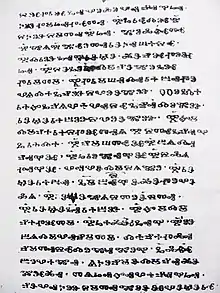Codex Zographensis
The Codex Zographensis (or Tetraevangelium Zographense; scholarly abbreviation Zo) is an illuminated Old Church Slavonic canon manuscript. It is composed of 304 parchment folios; the first 288 are written in Glagolitic containing Gospels and organised as Tetraevangelium (Matthew, Mark, Luke, and John), and the rest written in Cyrillic containing a 13th-century synaxarium. It is dated back to the end of the 10th or beginning of the 11th century.[1]
Discovery and publishing

The manuscript originally belonged to the Bulgarian Zograf Monastery on Mount Athos. It is said that it was kept at a conventual church near Ierisso and later transferred to the monastery's library. In 1843, the Croatian writer and Habsburgian diplomat Antun Mihanović discovered the manuscript during his stay at the monastery. The codex's importance was announced by the Russian historian and folklorist Victor Grigorovich who visited the monastery one year later and who is regarded as the founder of Slavonic studies in Russia. Izmail Sreznevsky published a first transcription of some parts of the manuscript in 1856.[2] In 1860 monks from the Zograf monastery donated the Codex to the Russian emperor Alexander II.[3] The donation was transferred to Russia during an archaeological expedition of Pyotr Sevastyanov (1811-1867).[4] In 1862, this archaeological collection was divided and transferred to different institutions in Moscow and Saint Petersburg. The Glagolitic codex became part of the collection of the Imperial Public Library, where the Codex is kept until today. The first who described the codex was Victor Grigorovich in 1877, and two years later the Glagolitic part of the codex was published by the Slavist Vatroslav Jagić in Berlin as Quattuor evangeliorum codex glagoliticus olim Zographensis nunc Petropolitanus, completely transcribed in Cyrillic, with an introduction and an extensive philological commentary in Latin.[1] Jagić's edition has been reprinted as a facsimile edition in Graz in 1954. Other scholars who have extensively studied the language of Codex Zographensis were Josef Kurz, Leszek Moszyński and the librarian Vyacheslav Zagrebin who was responsible for its restoration during the 1990s. During January 2016, monks of the Zograf monastery visited Saint Petersburg in order to report about a digitisation project of the manuscript which intended to make it available to the public. As result of their diplomatic visit a Zographensis room was established at the SS. Cyril and Methodius National Library in Sofia, and a virtual exhibition of the whole manuscript with a modernised transcription was published at the homepage of the Russian National Library.[5]
Content
The manuscript contains 304 parchment folios. The first few ones have not been preserved, and thus it begins with Matthew 3:11 and ends with John, with Mt 16:20-24:20 being later insertion in Old Church Slavonic Grammar.[6] In total, the first 288 folios are written in Glagolitic and contain Gospel text. In addition, several additional folios from the middle of the manuscript are missing. At the end of the 11th or beginning of the 12th century some missing folios (from 41 to 57) were replaced with 17 new ones, written in square Glagolitic. They were themselves most likely a palimpsest. The rest of the 16 folios contain 13th-century synaxarium.
Origin and linguistic features
Along with the slightly older Codex Marianus it is an important document for its use of the round Glagolitic script, the oldest recorded Slavic alphabet. By analyzing the language of the codex it was established that the style and antiquity of the text is nonuniform, second part being more archaic than the first part. Some scholars explain this by gradual adaptation to the language of the source from which the manuscript originated. Generally, phonology of the language of Codex Zographensis is archaic - vocalizations of strong yers are rare, epenthetic l is preserved, though in most parts of the manuscript yers are being assimilated.[1] It is a bit less archaic with respect to morphology and syntax, though the forms of definite declension of adjectives and older forms of participles are well-preserved (e.g. prošь, nošь and rarely prosivъ, nosivъ).[1]
Gallery
Footnotes
- Damjanović (2003:17)
- Кирилометодиевска енциклопедия, т. І, София 1985, с. 739-740
- See folio 1 with dedication signed by Anthimus, Archimandrite of the monastery (Zo, f.1r).
- See a short biography published by the Pushkin State Museum of Fine Arts.
- See the external link to this virtual exhibition, also made available in English (Zo).
- Lunt (2001:7)
References
- Jagić, Vatroslav (1879), Quattuor evangeliorum Codex glagoliticus olim Zographensis nunc Petropolitanus, Berolini
{{citation}}: CS1 maint: location missing publisher (link) - Damjanović, Stjepan (2003), Staroslavenski jezik, Zagreb: Hrvatska sveučilišna naklada, ISBN 953-169-095-2
- Schenker, Alexander (1995), The Dawn of Slavic: An Introduction to Slavic Philology, New Haven: Yale University Press, ISBN 0-300-05846-2
- Lunt, Horace G. (2001), Old Church Slavonic Grammar (7h revised ed.), New York: Mouton de Gruyter, ISBN 3-11-016284-9
Further reading
- V. Jagić: Studien über das altslovenische Zographosevangelium. Archiv für slavische Philologie I, II, 1876–1877.
- N. Grunskij: K Zografskomu evangeliju. In: Sbornik Otdelenija russkogo jazyka i slovesnosti Akademii Nauk LXXXIII, No. 3, 1907.
- N. van Wijk: Palaeoslovenica. I. O prototypie cerkiewno-sl/owian'skiego "Codex Zographensis". Rocznik Slawistyczny IX, 1921.
- N. van Wijk: Ešče raz o Zografskom četveroevangelii. Slavia I, 1922/23.
- J. Kurz: K Zografskému evangeliu. Slavia IX, 1930/31, XI, 1932.
External links
Manuscript
- "Saint Petersburg, Rossiyskaya Natsional'naya Biblioteka, Ms. Глаг. 1". “Codex Zographensis” (Zo) — Old Church Slavonic Tetraevangelium written in Glagolitic script by the Ohrid Literary School with later additions of the 12th (part of Matthew) and of the 13th (synaxaria added by Priest Ioan in Cyrillic) centuries (11th century). Saint Petersburg: National Library of Russia.
Editions
- Codex Zographensis transliterated in 7-bit ASCII, at the Corpus Cyrillo-Methodianum Helsingiense
- "Codex Zographensis on the basis of the edition by V. Jagić". TITUS. Frankfurt/Main: Jost Gippert. 2010.
Description
- Kempgen, Sebastian. "Codex Zographensis". Kodeks – OCS Sources. University Bamberg: Slavische Sprachwissenschaft. Archived from the original on 2012-02-04. Retrieved 2006-07-10.
Biography
- "Sevastyanov, Pyotr Ivanovich (1811–1867). St. Petersburg – Moscow". German prints. Moscow: Pushkin State Museum of Fine Arts.

